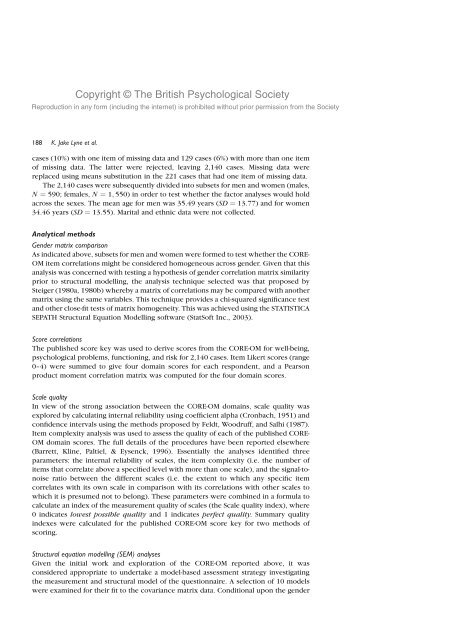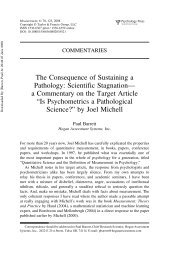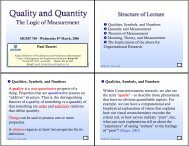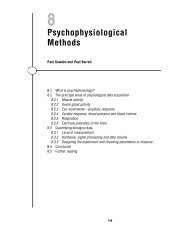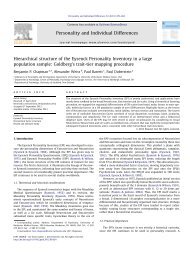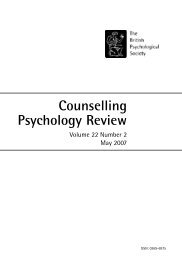Copyright © The British Psychological SocietyReproducti<strong>on</strong> in any form (including <strong>the</strong> internet) is prohibited without prior permissi<strong>on</strong> from <strong>the</strong> Society188K. Jake Lyne et al.cases (10%) with <strong>on</strong>e item <str<strong>on</strong>g>of</str<strong>on</strong>g> missing data and 129 cases (6%) with more than <strong>on</strong>e item<str<strong>on</strong>g>of</str<strong>on</strong>g> missing data. The latter were rejected, leaving 2,140 cases. Missing data werereplaced using means substituti<strong>on</strong> in <strong>the</strong> 221 cases that had <strong>on</strong>e item <str<strong>on</strong>g>of</str<strong>on</strong>g> missing data.The 2,140 cases were subsequently divided into subsets for men and women (males,N ¼ 590; females, N ¼ 1; 550) in order to test whe<strong>the</strong>r <strong>the</strong> factor analyses would holdacross <strong>the</strong> sexes. The mean age for men was 35.49 years (SD ¼ 13:77) and for women34.46 years (SD ¼ 13:55). Marital and ethnic data were not collected.Analytical methodsGender matrix comparis<strong>on</strong>As indicated above, subsets for men and women were formed to test whe<strong>the</strong>r <strong>the</strong> <strong>CORE</strong>-<strong>OM</strong> item correlati<strong>on</strong>s might be c<strong>on</strong>sidered homogeneous across gender. Given that thisanalysis was c<strong>on</strong>cerned with testing a hypo<strong>the</strong>sis <str<strong>on</strong>g>of</str<strong>on</strong>g> gender correlati<strong>on</strong> matrix similarityprior to structural modelling, <strong>the</strong> analysis technique selected was that proposed bySteiger (1980a, 1980b) whereby a matrix <str<strong>on</strong>g>of</str<strong>on</strong>g> correlati<strong>on</strong>s may be compared with ano<strong>the</strong>rmatrix using <strong>the</strong> same variables. This technique provides a chi-squared significance testand o<strong>the</strong>r close-fit tests <str<strong>on</strong>g>of</str<strong>on</strong>g> matrix homogeneity. This was achieved using <strong>the</strong> STATISTICASEPATH Structural Equati<strong>on</strong> Modelling s<str<strong>on</strong>g>of</str<strong>on</strong>g>tware (StatS<str<strong>on</strong>g>of</str<strong>on</strong>g>t Inc., 2003).Score correlati<strong>on</strong>sThe published score key was used to derive scores from <strong>the</strong> <strong>CORE</strong>-<strong>OM</strong> for well-being,psychological problems, functi<strong>on</strong>ing, and risk for 2,140 cases. Item Likert scores (range0–4) were summed to give four domain scores for each resp<strong>on</strong>dent, and a Pears<strong>on</strong>product moment correlati<strong>on</strong> matrix was computed for <strong>the</strong> four domain scores.Scale qualityIn view <str<strong>on</strong>g>of</str<strong>on</strong>g> <strong>the</strong> str<strong>on</strong>g associati<strong>on</strong> between <strong>the</strong> <strong>CORE</strong>-<strong>OM</strong> domains, scale quality wasexplored by calculating internal reliability using coefficient alpha (Cr<strong>on</strong>bach, 1951) andc<strong>on</strong>fidence intervals using <strong>the</strong> methods proposed by Feldt, Woodruff, and Salhi (1987).Item complexity analysis was used to assess <strong>the</strong> quality <str<strong>on</strong>g>of</str<strong>on</strong>g> each <str<strong>on</strong>g>of</str<strong>on</strong>g> <strong>the</strong> published <strong>CORE</strong>-<strong>OM</strong> domain scores. The full details <str<strong>on</strong>g>of</str<strong>on</strong>g> <strong>the</strong> procedures have been reported elsewhere(<strong>Barrett</strong>, Kline, Paltiel, & Eysenck, 1996). Essentially <strong>the</strong> analyses identified threeparameters: <strong>the</strong> internal reliability <str<strong>on</strong>g>of</str<strong>on</strong>g> scales, <strong>the</strong> item complexity (i.e. <strong>the</strong> number <str<strong>on</strong>g>of</str<strong>on</strong>g>items that correlate above a specified level with more than <strong>on</strong>e scale), and <strong>the</strong> signal-t<strong>on</strong>oiseratio between <strong>the</strong> different scales (i.e. <strong>the</strong> extent to which any specific itemcorrelates with its own scale in comparis<strong>on</strong> with its correlati<strong>on</strong>s with o<strong>the</strong>r scales towhich it is presumed not to bel<strong>on</strong>g). These parameters were combined in a formula tocalculate an index <str<strong>on</strong>g>of</str<strong>on</strong>g> <strong>the</strong> measurement quality <str<strong>on</strong>g>of</str<strong>on</strong>g> scales (<strong>the</strong> Scale quality index), where0 indicates lowest possible quality and 1 indicates perfect quality. Summary qualityindexes were calculated for <strong>the</strong> published <strong>CORE</strong>-<strong>OM</strong> score key for two methods <str<strong>on</strong>g>of</str<strong>on</strong>g>scoring.Structural equati<strong>on</strong> modelling (SEM) analysesGiven <strong>the</strong> initial work and explorati<strong>on</strong> <str<strong>on</strong>g>of</str<strong>on</strong>g> <strong>the</strong> <strong>CORE</strong>-<strong>OM</strong> reported above, it wasc<strong>on</strong>sidered appropriate to undertake a model-based assessment strategy investigating<strong>the</strong> measurement and structural model <str<strong>on</strong>g>of</str<strong>on</strong>g> <strong>the</strong> questi<strong>on</strong>naire. A selecti<strong>on</strong> <str<strong>on</strong>g>of</str<strong>on</strong>g> 10 modelswere examined for <strong>the</strong>ir fit to <strong>the</strong> covariance matrix data. C<strong>on</strong>diti<strong>on</strong>al up<strong>on</strong> <strong>the</strong> gender
Copyright © The British Psychological SocietyReproducti<strong>on</strong> in any form (including <strong>the</strong> internet) is prohibited without prior permissi<strong>on</strong> from <strong>the</strong> Society<str<strong>on</strong>g>Dimensi<strong>on</strong>s</str<strong>on</strong>g> <str<strong>on</strong>g>of</str<strong>on</strong>g> <str<strong>on</strong>g>variati<strong>on</strong></str<strong>on</strong>g> <strong>on</strong> <strong>the</strong> <strong>CORE</strong>-<strong>OM</strong> 189matrix comparis<strong>on</strong> results, <strong>the</strong>se models would be fit to ei<strong>the</strong>r separate gender matricesor <strong>the</strong> total sample matrix <str<strong>on</strong>g>of</str<strong>on</strong>g> 2,140 cases.The first model tested was <strong>the</strong> established <strong>CORE</strong>-<strong>OM</strong> model and this was <strong>the</strong>nsystematically varied in terms <str<strong>on</strong>g>of</str<strong>on</strong>g> alternative c<strong>on</strong>ceptualizati<strong>on</strong>s <str<strong>on</strong>g>of</str<strong>on</strong>g> <strong>the</strong> <strong>CORE</strong>-<strong>OM</strong>structure. This model-testing process is designed as a comprehensive series <str<strong>on</strong>g>of</str<strong>on</strong>g> testswhose aim is to try to establish <strong>the</strong> optimum psychometric factor model for <strong>CORE</strong>-<strong>OM</strong>.All SEM analyses were c<strong>on</strong>ducted using both SPSS AMOS-5 (Arbuckle, 2003) andSTATISTICA SEPATH s<str<strong>on</strong>g>of</str<strong>on</strong>g>tware, to provide an internal check <strong>on</strong> modelling setup andspecificati<strong>on</strong>s, as well as <strong>the</strong> calculati<strong>on</strong> <str<strong>on</strong>g>of</str<strong>on</strong>g> <strong>the</strong> McD<strong>on</strong>ald (1989) N<strong>on</strong>-centrality Indexwithin SEPATH. SEM analyses were undertaken <strong>on</strong> covariance matrices in AMOS, withoutput expressed in standardized form (which corresp<strong>on</strong>ds to <strong>the</strong> completelystandardized soluti<strong>on</strong> in SEPATH). Five indices were used to gauge goodness-<str<strong>on</strong>g>of</str<strong>on</strong>g>-fit <str<strong>on</strong>g>of</str<strong>on</strong>g>each model-implied covariance matrix to <strong>the</strong> sample covariance matrix. These were <strong>the</strong>chi-squared exact-fit test, and four close-fit tests comprising <strong>the</strong> McD<strong>on</strong>ald n<strong>on</strong>-centralityindex (Mc), Steiger and Lind’s (1980) root mean squared error <str<strong>on</strong>g>of</str<strong>on</strong>g> approximati<strong>on</strong>(RMSEA), Bentler’s (1990) comparative fit index (CFI), and <strong>the</strong> standardized root meansquare residual index (SRMR). The chi-squared alpha for null-hypo<strong>the</strong>sis testing was setat .05. Suggested minimum values indicating acceptable model-fit for <strong>the</strong> close-fit testindices were taken from Hu and Bentler (1999). These were .90 or greater for Mc, .06 orless for RMSEA, .95 or greater for CFI, and .08 or less for SRMR.General factor models for <strong>CORE</strong>-<strong>OM</strong> were tested using <strong>the</strong> nested factors model(Gustafss<strong>on</strong> & Balke, 1993). This is a method <str<strong>on</strong>g>of</str<strong>on</strong>g> determining <strong>the</strong> extent to which eachfirst-order latent variable can be c<strong>on</strong>sidered causal for <strong>the</strong> co<str<strong>on</strong>g>variati<strong>on</strong></str<strong>on</strong>g> between a group<str<strong>on</strong>g>of</str<strong>on</strong>g> manifest variable resp<strong>on</strong>ses; this co<str<strong>on</strong>g>variati<strong>on</strong></str<strong>on</strong>g> is modelled as independent from <strong>the</strong>causal influence <str<strong>on</strong>g>of</str<strong>on</strong>g> a hypo<strong>the</strong>sized general first-order latent variable. In essence, eachlatent variable is ‘residualized’ with respect to <strong>the</strong> general factor latent (i.e. is orthog<strong>on</strong>alto it).Difference in goodness-<str<strong>on</strong>g>of</str<strong>on</strong>g>-fit between models was tested using <strong>the</strong> chi-squared test.ResultsGender matrix comparis<strong>on</strong>The results <str<strong>on</strong>g>of</str<strong>on</strong>g> <strong>the</strong> analysis comparing <strong>the</strong> two <strong>CORE</strong>-<strong>OM</strong> correlati<strong>on</strong> matrices from maleand female resp<strong>on</strong>dents for homogeneity <str<strong>on</strong>g>of</str<strong>on</strong>g> coefficients yielded a chi-squared goodness<str<strong>on</strong>g>of</str<strong>on</strong>g>-fitstatistic <str<strong>on</strong>g>of</str<strong>on</strong>g> 819.06, df ¼ 561, p , :0001, which indicated an exact-fit rejecti<strong>on</strong> <str<strong>on</strong>g>of</str<strong>on</strong>g><strong>the</strong> null hypo<strong>the</strong>sis <str<strong>on</strong>g>of</str<strong>on</strong>g> no-difference. However, <strong>the</strong> close-fit index <str<strong>on</strong>g>of</str<strong>on</strong>g> RMSEA was .019,with 90% c<strong>on</strong>fidence interval between .016 and .022, and SRMR ¼ .031. The largeststandardized residual correlati<strong>on</strong> was just .035. This value, al<strong>on</strong>g with <strong>the</strong> informati<strong>on</strong>from <strong>the</strong> close-fit tests, indicated that <strong>the</strong> two gender matrices might reas<strong>on</strong>ably bec<strong>on</strong>sidered homogeneous, given we are c<strong>on</strong>tent to accept that <strong>the</strong> largest observeddiscrepancy between <strong>the</strong> residual correlati<strong>on</strong>s is as low as .035. The mean standardizedresidual correlati<strong>on</strong> discrepancy is .001. Therefore, both male and female datasets werecombined into a total sample dataset <str<strong>on</strong>g>of</str<strong>on</strong>g> N ¼ 2; 140, which was used in all subsequentanalyses.Domain score correlati<strong>on</strong>s and scale qualityA Pears<strong>on</strong>’s product moment correlati<strong>on</strong> matrix was calculated for <strong>the</strong> sums <str<strong>on</strong>g>of</str<strong>on</strong>g> scoresfor each <str<strong>on</strong>g>of</str<strong>on</strong>g> <strong>the</strong> four <strong>CORE</strong>-<strong>OM</strong> domains for all 2,140 cases. All correlati<strong>on</strong>s in Table 1 aresignificant at p , :0001.


